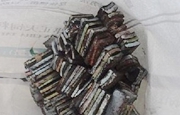Turning old into new
 Permanent magnets recycle means the extracting the rare earth elements from the magnets again. However it is very hard and expensive. The scientists of the Fraunhofer Project Group for Materials Recycling and Resource Strategies IWKS in Alzenau and Hanau of the Fraunhofer Institute for Silicate Research ISC are now pursuing a different approach to recycle the entire material instead of trying to regain each individual type of rare earth.Because the composition of the material is already almost as it should be, this process only need a few steps, and this is much easier and more efficient.
Permanent magnets recycle means the extracting the rare earth elements from the magnets again. However it is very hard and expensive. The scientists of the Fraunhofer Project Group for Materials Recycling and Resource Strategies IWKS in Alzenau and Hanau of the Fraunhofer Institute for Silicate Research ISC are now pursuing a different approach to recycle the entire material instead of trying to regain each individual type of rare earth.Because the composition of the material is already almost as it should be, this process only need a few steps, and this is much easier and more efficient.
First magnet successfully recycled
The scientists rely on the melt spinning process that already tried and tested for other alloys,also known as “rapid solidification”. The details is as below:
|
The researchers liquefy the magnet in a melting pot. The liquefied material, heated to more than 1000 degrees Celsius, is directed via a nozzle onto a water-cooled copper wheel that rotates at a speed of 10 to 35 meters per second. As soon as the melted droplet comes into contact with the copper, it transfers its heat to the metal within fractions of a second and solidifies. The scientists call the emerging material formations "flakes". The special feature is the structure formed inside the flakes. If the melted material were allowed to solidify in the normal way, the atoms would "line up in rows" in a crystal lattice. In the melt spinning procedure however, crystallization is avoided: Either an amorphous structure is formed, in which the atoms are completely irregularly arranged, or a nanocrystalline structure, in which the atoms arrange themselves in nanometer-sized grains to form a crystalline structure. The advantage: The grain sizes – meaning the areas with the same crystalline structure – can be specifically varied. They can be used to change the properties of the permanent magnet. In a further step, the researchers mill the flakes into a powder, which can then be further processed. “We press it into its final shape”, Diehl says BY FRAUNHOFER ISE EUROPE, GERMANY, RENEWABLE ENERGY, RESEARCH NEWS, TRANSPORTATION, WIND ENERGYDECEMBER 30, 2015 |
Now they have already set up a demonstration plant and have managed to recycle magnets there. This demo system can process up to half a kilogram of molten material and is somewhere between a lab and a large-scale plant.
In many cases, the magnets are extremely difficult to remove from the engines. So the potential ways of creating a collection cycle for used engines, and also of a design more suitable for disassembly is what the scientists want to develop. If the price of rare earth elements continue to go up, magnet recycling will be more cost-efficient and recycling permanent magnets from wind turbines and electric motors will be popular.
 China Magnets Source Material Limited
China Magnets Source Material Limited